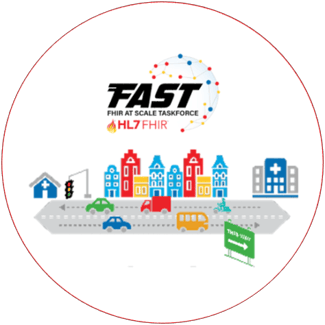HIT Perspectives
Subscribe
HIT Perspectives – May 2023
Gaining Momentum with FHIR Through FAST
 By Melissa Bundy, Marketing Lead & FAST Communications Support
By Melissa Bundy, Marketing Lead & FAST Communications Support
Quick Summary
- APIs power the interoperable, user-friendly interfaces we’ve all grown accustomed to in the financial and online retail industries. Healthcare must follow
- Policy is driving the move to APIs in healthcare, however, a strong FHIR infrastructure is critical to enable scalable implementation of FHIR APIs and the use of FHIR Implementations created to answer critical use cases
- The HL7 FAST Accelerator are working towards creating a national FHIR infrastructure for an interoperable healthcare ecosystem
- FAST is developing implementation guides to help solve common implementation challenges and collaborating across the FHIR community to ensure alignment in approaches to initiatives such as the Trusted Exchange Framework and Common Agreement FHIR Roadmap
- FAST members include industry leaders across the healthcare ecosystem, from providers to payers, vendors, and government agencies. Organizations can contribute their expertise to FAST and apply for membership
An interoperable healthcare ecosystem provides the right data to the right people at the right time across providers, payers and other health information technology (health IT) stakeholders. This kind of information accessibility at your fingertips already exists in mobile banking, thanks to the ubiquity of application programming interfaces (APIs) and modern, real-time data standards. In fact, the ease with which consumers engage in financial transactions of any kind, anywhere, at any time across multiple institutions has become almost an afterthought in today’s FAST-paced, on-the-go world.
According to a 2021 study by J.D. Powers, 67% of Americans use smartphones and mobile banking apps on a daily basis to check balances, deposit checks, pay bills, transfer funds, and more. It is typically seamless to move money between accounts and separate institutions. While consumers likely take these banking functionalities for granted, patients wish they could access and share their medical records with such ease. It goes without saying that providers, payers, public health officials, and even pharmacists would also love to share health care data as seamlessly as their peers in finance.
For all the strides made via public policies and private-sector innovations, health care data in many ways remain siloed and inaccessible. While those silos do seem to be shrinking as health care makes greater strides toward interoperability, accessing and sharing the data within them is often still a manual process. A major barrier to truly open information exchange in health care is a lack of consistently used data standards. When organizations use the same terminology and technology to collect and store patient health information, the data can be shared, used, and reused by multiple stakeholders. Creating tools and infrastructure that not only standardize the data but also ensure scalability as new standards emerge is critical. That’s where FAST Healthcare Interoperability Resources (FHIR) and the HL7 FHIR at Scale Task Force (FAST) Accelerator come in.
 Federal Initiatives Supporting FHIR Adoption Led to FAST
Federal Initiatives Supporting FHIR Adoption Led to FAST
FHIR standardization and scalability have been top of mind for Point-of-Care Partners (POCP) Senior Health IT Consultant and Payer/Practice Lead Jocelyn Keegan, Providence Chief Operating Officer of Population Health Deepak Sadagopan, and Smile Digital Health Chief Executive Officer Duncan Weatherston for some time. All three are members of the FAST Accelerator, which got its start as an Office of the National Coordinator for Health IT (ONC) initiative and then transitioned into an HL7 accelerator last year. (The trio joined POCP Consultant Ken Kleinberg on a recent episode of POCP’s The Dish on Health IT podcast, which readers can listen to here.)
The idea for a taskforce dedicated to FHIR scalability and infrastructure was born from within the HL7 Da Vinci Project, which focuses on payer/provider data exchange to support value-based care agreements. Da Vinci participants recognized that capability gaps existed in the FHIR standards being developed and that those gaps would prevent widespread deployment of those standards.
Keegan, who is also a program manager for the Da Vinci Project, says that one barrier to achieving the sought-after, banking-like level of sharable and searchable access to relevant data is a lack of consistency in the adoption of standards, with another barrier being a lack of awareness of which organizations have already implemented FHIR standards and have a live FHIR server. This discovery process is currently manual and time-consuming because there is no universal endpoint directory.
FHIR implementers have also faced shared challenges related to security, identity management, endpoint discovery, and versioning, among others. It has become clear that a national FHIR infrastructure is critical to addressing these challenges and attaining scalability and wide adoption. FAST is working to address these common challenges and provide the tools for building a national FHIR infrastructure to enable scalable FHIR solutions. Ultimately, FAST’s goal is to help all health IT stakeholders adopt consistent standards that allow them to publish data to a shared directory, where they can be accessed by other verified stakeholders.
FAST Is an Accelerator for All Accelerators
FAST differs from other accelerators in that it is not focused on functional use cases but rather works to develop a framework for a national FHIR infrastructure. This includes implementation guides (IGs) to help solve common implementation challenges, in addition to collaborating across the FHIR community to ensure there is alignment in approaches to initiatives like ONC’s Trusted Exchange Framework and Common Agreement (TEFCA) FHIR Roadmap, policy responses, and FHIR implementation.
FAST has developed four IGs that are the result of collaborative efforts and have been refined through rigorous testing to provide transparent development guided by real-world input and application. It is also working to combine three national directory IGs into a single IG entitled the “National Directory for Healthcare Providers and Services” based on community feedback and input. FAST’s directory work was named in the CMS National Directory Request for Information. You can find a complete list of projects and meeting schedules here.
Participate in FAST as a Member or by Attending Workgroups
FAST members include industry leaders across the healthcare ecosystem. From providers to payers, vendors, and government agencies, the growing group lends its insights and perspectives to help create solutions that will benefit their organizations and the industry as a whole. Members gain a broader understanding of new policies by participating in the responses to proposed rulemaking and are privy to the most current information about what is happening within the FHIR community. Reach out to FAST@hl7.org to learn more about specific ways your organization can contribute its expertise or visit the FAST home page. You can also sign up to receive notifications of new developments, join presentations, or apply for membership.
Reach Out Today
Keegan and POCP Consultant Dana Marcelonis, who also serves as program manager for FAST, frequently share their insights on the importance of FHIR infrastructure and how proposed policy changes will affect implementation during POCP podcasts and webinars and at leading industry events. We seek leadership roles within these accelerators in order to collaborate with the broad range of stakeholders that coexist in the healthcare ecosystem. We’d love to hear your ideas and goals for interoperability. Reach out any time to ask questions or share issues you’d like to discuss related to FAST or FHIR-based APIs. Email Dana.Marcelonis@pocp.com or Jocelyn.Keegan@pocp.com.




